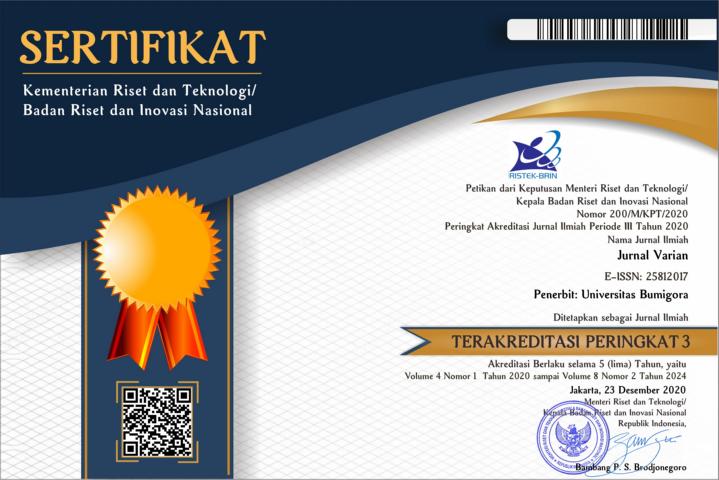K-Means – Resilient Backpropagation Neural Network in Predicting Poverty Levels
Abstract
In solving economic problems, the government has implemented several development policies. However, this policy is considered to be too centered on big cities. So, through this research it is hoped that it can provide an overview related to regional groups that fall into the poorer category so that the government can also provide accelerated development policies that are oriented towards improving the economy of residents in the area. This study aims to determine the results of classifying district/city poverty levels in Indonesia as a basis for classification for predictions and to classify district/city poverty levels based on influencing factors. The method used in this study is K-Means Clustering using the poverty depth index and poverty severity index variables, then proceed with using the Backpropagation Neural Network (BNN) algorithm using the GRDP, per capita expenditure, human development index, and mean years of schooling. The results obtained using the K-Means algorithm are that there are 42 districts/cities that belong to cluster 1 where this region has a poverty index depth and severity index value that is higher than the 472 districts/cities in cluster 2. Furthermore, the cluster results are used as response variables for classification with BNN. The accuracy of the model obtained is very high, which is equal to 98.06, so the model is very feasible to be used as a poverty rate prediction model based on the variables used.
References
Annas, Suwardi, Poerwanto, B., Sapriani, S., & S, M. F. (2022). Implementation of K-Means Clustering on Poverty Indicators in Indonesia. MATRIK : Jurnal Manajemen, Teknik Informatika Dan Rekayasa Komputer, 21(2), 257–266. https://doi.org/10.30812/matrik.v21i2.1289
Annur, H. (2018). Klasifikasi Masyarakat Miskin Menggunakan Metode Naive Bayes. ILKOM Jurnal Ilmiah, 10(2), 160–165. https://doi.org/10.33096/ilkom.v10i2.303.160-165
Askari, S. (2021). Fuzzy C-Means clustering algorithm for data with unequal cluster sizes and contaminated with noise and outliers: Review and development. Expert Systems with Applications, 165, 1–71. https://doi.org/10.1016/j.eswa.2020.113856
Barchitta, M., Maugeri, A., Favara, G., Riela, P. M., La Mastra, C., La Rosa, M. C., Magnano San Lio, R., Gallo, G., Mura, I., Agodi, A., Salesia, F., Ennio, S., Montagna, M. T., Squeri, R., Di Bartolo, R. M., Salvatore, T., Mattaliano, A. R., Bellocchi, P., Castiglione, G., … Farruggia, P. (2021). Cluster analysis identifies patients at risk of catheter-associated urinary tract infections in intensive care units: findings from the SPIN-UTI Network. Journal of Hospital Infection, 107, 57–63. https://doi.org/10.1016/j.jhin.2020.09.030
Bustan, M. N., & Poerwanto, B. (2021). Logistic Regression Model of Relationship between Breast Cancer Pathology Diagnosis with Metastasis. Journal of Physics: Conference Series, 1752(1), 1–5. https://doi.org/10.1088/1742-6596/1752/1/012026
Butarbutar, N., Windarto, A. P., Hartama, D., & Solikhun. (2016). Komparasi Kinerja Algoritma Fuzzy C-Means dan K-Means dalam Pengelompokan Data Siswa Berdasarkan Prestasi Nilai Akademik Siswa (Studi Kasus : SMP Negeri 2 Pematangsiantar). JURASIK (Jurnal Riset Sistem Informasi & Teknik Informatika), 1(1), 46–55.
Chalid, N., & Yusuf, Y. (2014). Pengaruh Tingkat Kemiskinan dan Tingkat Pengangguran, Upah Minimun Kabupaten/Kota Dan Laju Pertumbuhan Ekonomi Terhadap Indeks Pembangunan Manusia di Provinsi Riau. Jurnal Ekonomi, 22(2), 1–12. http://ejournal.unri.ac.id/index.php/JE/article/viewFile/2592/2547%0A
Hamed, A. A. M., Li, R., Xiaoming, Z., & Xu, C. (2013). Logistic Regression. Advances in Multimedia, 1–6.
Heil, J., Häring, V., Marschner, B., & Stumpe, B. (2019). Advantages of fuzzy k-means over k-means clustering in the classification of diffuse reflectance soil spectra: A case study with West African soils. Geoderma, 337, 11–21. https://doi.org/10.1016/j.geoderma.2018.09.004
Kakushadze, Z., & Yu, W. (2017). Biomolecular Detection and Quanti fi cation * K-means and cluster models for cancer signatures. Biomolecular Detection and Quantification, July, 1–25. https://doi.org/10.1016/j.bdq.2017.07.001
Meng, Y., Liang, J., Cao, F., & He, Y. (2018). A new distance with derivative information for functional k-means clustering algorithm. Information Sciences, 463–464, 166–185. https://doi.org/10.1016/j.ins.2018.06.035
Pawara, P., Okafor, E., Groefsema, M., He, S., Schomaker, L. R. B., & Wiering, M. A. (2020). One-vs-One classification for deep neural networks. Pattern Recognition, 108, 1–13. https://doi.org/10.1016/j.patcog.2020.107528
Poerwanto, B. (2021). Evaluating the K-Means Analysis in Clustering Area Based on Estates Productivity in Tana Luwu Using Silhouette Index. Journal of Physics: Conference Series, 1752(1), 0–7. https://doi.org/10.1088/1742-6596/1752/1/012014
Poerwanto, Bobby, & Ali, B. (2019). Implementasi Algoritma Fuzzy C-Means dalam Mengelompokkan Kecamatan di Tana Luwu Berdasarkan Produktifitas Hasil Perkebunan. MATRIK : Jurnal Manajemen, Teknik Informatika Dan Rekayasa Komputer, 19(1), 163–172. https://doi.org/10.30812/matrik.v19i1.499
Poerwanto, Bobby, & Fajriani, F. (2020). Resilient Backpropagation Neural Network on Prediction of Poverty Levels in South Sulawesi. MATRIK : Jurnal Manajemen, Teknik Informatika Dan Rekayasa Komputer, 20(1), 11–18. https://doi.org/10.30812/matrik.v20i1.726
Rusdarti, & Sebayang, L. K. (2013). Faktor-Faktor Yang Mempengaruhi Tingkat Kemiskinan Di Provinsi Jawa Tengah. Jurnal Economia, 9(1), 1–9. https://doi.org/10.21831/economia.v9i1.1371
Suparman, P., & Zainuddin, A. (2019). Implementasi Metode K-Nearest Neighbor untuk Klasifikasi Penduduk Miskin di Desa Ngemplak Kidul Kabupaten Pati Jawa Tengah. Jurnal Informatika SIMANTIK, 4(1), 21–28.
Tiro, M. A., Poerwanto, B., & Fahmuddin, M. (2021). Logistics Regression Modelling on Student Career Path Choices at the Statistics Department, FMIPA UNM Makassar. Journal of Physics: Conference Series, 2123(1), 012002. https://doi.org/10.1088/1742-6596/2123/1/012002
Vishwakarma, G. K., Paul, C., & Elsawah, A. M. (2020). An algorithm for outlier detection in a time series model using backpropagation neural network. Journal of King Saud University - Science, 32(8), 3328–3336. https://doi.org/10.1016/j.jksus.2020.09.018
Xu, J., Tan, W., & Li, T. (2020). Predicting fan blade icing by using particle swarm optimization and support vector machine algorithm. Computers and Electrical Engineering, 87, 106751. https://doi.org/10.1016/j.compeleceng.2020.106751
Zhang, L., Wei, Y., & Chu, E. K. wah. (2020). Neural network for computing GSVD and RSVD. Neurocomputing, xxxx. https://doi.org/10.1016/j.neucom.2020.10.057
Zhao, Q., Liu, Q., Cao, N., Guan, F., Wang, S., & Wang, H. (2021). Stepped generalized predictive control of test tank temperature based on backpropagation neural network. Alexandria Engineering Journal, 60(1), 357–364. https://doi.org/10.1016/j.aej.2020.08.032

This work is licensed under a Creative Commons Attribution 4.0 International License.


















